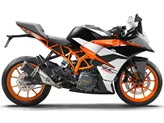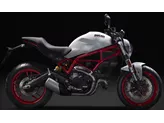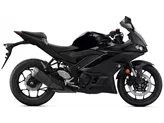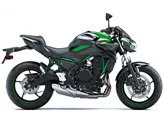Kawasaki Ninja 400 2018 vs. Kawasaki Z650 2017

Kawasaki Ninja 400 2018

Kawasaki Z650 2017
Přehled - Kawasaki Ninja 400 2018 vs Kawasaki Z650 2017
The Kawasaki Ninja 400 2018 and the Kawasaki Z650 2017 are both popular models from Kawasaki, but they have some key differences in terms of their technical specifications and strengths.
Starting with the technical specifications, the Ninja 400 is equipped with a 399cc in-line engine, while the Z650 has a larger 649cc in-line engine. The Ninja 400 has a maximum power output of 45 HP, while the Z650 boasts a higher power output of 68.2 HP. The torque on the Ninja 400 is 38 Nm, whereas the Z650 has a higher torque of 65.7 Nm. The Ninja 400 has a compression ratio of 11.5, while the Z650 has a slightly lower compression ratio of 10.8. Both models have fuel injection systems and liquid cooling.
In terms of suspension, both the Ninja 400 and the Z650 have telescopic forks in the front and swing arm suspensions in the rear. The front suspension on both models has a diameter of 41 mm. The rear suspension on both models is equipped with a monoshock, but the Z650 has the added feature of preload adjustment. The chassis on both models is made of steel and has a tubular frame design. The rake on the Ninja 400 is 63 degrees, while the Z650 has a slightly steeper rake of 65.5 degrees. The trail on the Ninja 400 is 93 mm, while the Z650 has a slightly longer trail of 100 mm.

Kawasaki Ninja 400 2018
In terms of braking, the Ninja 400 is equipped with a single disc front brake with a diameter of 310 mm and a double piston caliper. The Z650, on the other hand, has double disc front brakes with a diameter of 300 mm and a double piston caliper. Both models have petal technology for improved performance. Both models also have ABS as an advanced rider assistance system.
In terms of dimensions and weights, the Ninja 400 has a front tire width of 110 mm and a rear tire width of 150 mm. The Z650 has a slightly wider front tire width of 120 mm and a rear tire width of 160 mm. Both models have 17-inch front and rear tire diameters. The wheelbase on the Ninja 400 is 1370 mm, while the Z650 has a slightly longer wheelbase of 1410 mm. The seat height on the Ninja 400 is 785 mm, while the Z650 has a slightly higher seat height of 790 mm. The kerb weight of the Ninja 400, with ABS, is 168 kg, while the Z650 has a slightly higher kerb weight of 187.1 kg. Both models have fuel tank capacities of 14 liters for the Ninja 400 and 15 liters for the Z650.
Moving on to the strengths of each model, the Ninja 400 has a chassis that is suitable for sporty use, making it ideal for those who enjoy aggressive riding. It also has a low weight, which contributes to its effortless handling. The engine on the Ninja 400 has a smooth response, providing a satisfying riding experience. The relaxed and confidence-enhancing seating position of the Ninja 400 is another strength, as it allows riders to feel comfortable and in control. Additionally, the Ninja 400 is equipped with LED headlights, which provide improved visibility.
On the other hand, the Z650 has its own set of strengths. It offers an even power delivery, allowing riders to have a smooth and consistent riding experience. The sporty chassis of the Z650 contributes to its agile and responsive handling. The compact dimensions of the Z650 make it easy to maneuver in tight spaces. Another unique feature of the Z650 is its negative display, which adds a modern and stylish touch to the overall design.

Kawasaki Z650 2017
In terms of weaknesses, the Ninja 400 has non-adjustable brake and clutch levers, which may not be ideal for riders who prefer personalized settings. Additionally, riders over 180cm tall may experience enormously loud wind noise with the original windshield of the Ninja 400.
On the other hand, the Z650 may be a little too small for tall people, which could affect their comfort and riding experience.
In conclusion, both the Kawasaki Ninja 400 2018 and the Kawasaki Z650 2017 have their own unique strengths and weaknesses. The Ninja 400 excels in terms of its sporty chassis, low weight, smooth engine response, comfortable seating position, and LED headlights. On the other hand, the Z650 offers an even power delivery, sporty chassis, compact dimensions, and a stylish negative display. Ultimately, the choice between the two models will depend on the rider's preferences and priorities.
Technické údaje Kawasaki Ninja 400 2018 ve srovnání s Kawasaki Z650 2017
Výhody a nevýhody ve srovnání
Výhody a nevýhody ve srovnání
Kawasaki Ninja 400 2018

Celkově lze model Ninja 400 označit za dokonalý vstup do světa supersportů. Větší výkon u modelu A2 neseženete, vzhled napovídá o mnohem větším výkonu, vozidlo je hravé na ovládání, je ve všech ohledech shovívavé a přesto umožňuje opravdu sportovní styl jízdy. Ti, kteří měli oprávněné obavy z nedostatku výkonu u různých strojů s objemem 250 ccm, se nyní již nemají na co vymlouvat. Ninja 400, je dobře, že tě máme!
Kawasaki Z650 2017

Kawasaki Z 650 je špičkou střední třídy pro malé jezdce a jezdkyně. Na jejích kompaktních rozměrech se pravděpodobně nebudete cítit pohodlně jako obři. Hřejivé pocity však přináší motor, který potěší velmi plynulým zátahem. Po stránce podvozku bylo zvoleno pro Kawasaki typické těsné nastavení, které při každodenním používání nachází skvělý kompromis. Negativní displej je velmi dobře čitelný a připomíná svého předchůdce ER-6n - velmi pěkné!
Srovnání cen průměrná tržní cena Kawasaki Ninja 400 vs Kawasaki Z650
There are a few key differences between a Kawasaki Ninja 400 2018 and a Kawasaki Z650 2017. In terms of price, the actual average price of a Kawasaki Z650 2017 is about 5% higher. A Kawasaki Ninja 400 2018 experiences a loss of 130 USD in one year and 180 USD in two years of ownership. This is offset by a loss of 340 USD and 520 USD for a Kawasaki Z650 2017. Compared to Kawasaki Z650 2017 there are less Kawasaki Ninja 400 2018 bikes available on the 1000PS.de Marketplace, specifically 10 compared to 11. It takes less time to sell a Kawasaki Z650 with 76 days compared to 105 days for the Kawasaki Ninja 400. Since model year 2018 1000PS.de editors have written 9 reviews for the Kawasaki Ninja 400 and 31 reviews for the Kawasaki Z650 since model year 2017. The first review for the Kawasaki Ninja 400 was published on 11/22/2017 and now has more than 44,300 views. This compares to more than 25,000 views for the first review on Kawasaki Z650 published on 11/8/2016.


















